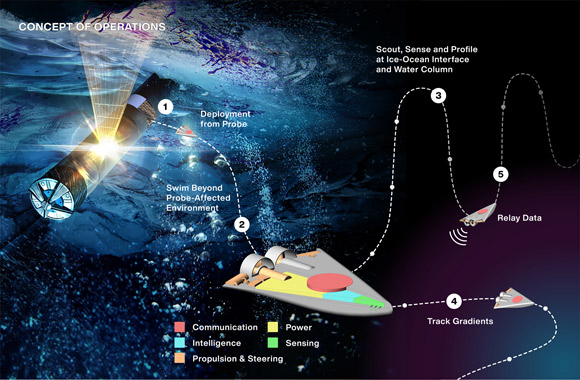That’s the vision of Dr. Ethan Schaler of NASA’s Jet Propulsion Laboratory, whose Sensing With Independent Micro-Swimmers (SWIM) concept was recently awarded $600,000 in Phase II funding from the NASA Innovative Advanced Concepts (NIAC) program.

This illustration shows the NASA cryobot concept called Probe using Radioisotopes for Icy Moons Exploration (PRIME) deploying tiny SWIM robots into the ocean miles below a lander on the frozen surface of an ocean world. Image credit: NASA / JPL-Caltech.
“My idea is, where can we take miniaturized robotics and apply them in interesting new ways for exploring our Solar System?” Dr. Schaler said.
“With a swarm of small swimming robots, we are able to explore a much larger volume of ocean water and improve our measurements by having multiple robots collecting data in the same area.”
Not yet part of any NASA mission, the SWIM concept envisions wedge-shaped robots, each about 12 cm (5 inches) long.
About four dozen of them could fit in a 10-cm- (4-inch) long section of a cryobot 25 cm (10 inches) in diameter, taking up just about 15% of the science payload volume.
That would leave plenty of room for more powerful but less mobile science instruments that could gather data during the long journey through the ice and provide stationary measurements in the ocean.
As ambitious as the SWIM concept is, its intent would be to reduce risk while enhancing science.
The cryobot would be connected via a communications tether to the surface-based lander, which would in turn be the point of contact with mission controllers on Earth.
That tethered approach, along with limited space to include large propulsion system, means the cryobot would likely be unable to venture much beyond the point where ice meets ocean.

In the SWIM concept, dozens of small robots would descend through the icy shell of a distant moon via a cryobot to the ocean below. Image credit: NASA / JPL-Caltech.
“What if, after all those years it took to get into an ocean, you come through the ice shell in the wrong place?” said SWIM team scientist Dr. Samuel Howell, also of NASA’s Jet Propulsion Laboratory.
“What if there’s signs of life over there but not where you entered the ocean?”
“By bringing these swarms of robots with us, we’d be able to look ‘over there’ to explore much more of our environment than a single cryobot would allow.”
SWIM would also allow data to be gathered away from the cryobot’s blazing-hot nuclear battery, which the probe would rely on to melt a downward path through the ice.
Once in the ocean, that heat from the battery would create a thermal bubble, slowly melting the ice above and potentially causing reactions that could change the water’s chemistry.
Additionally, the SWIM robots could flock together in a behavior inspired by fish or birds, thereby reducing errors in data through their overlapping measurements.
That group data could also show gradients: temperature or salinity, for example, increasing across the swarm’s collective sensors and pointing toward the source of the signal they’re detecting.
“If there are energy gradients or chemical gradients, that’s how life can start to arise. We would need to get upstream from the cryobot to sense those,” Dr. Schaler said.



GIPHY App Key not set. Please check settings